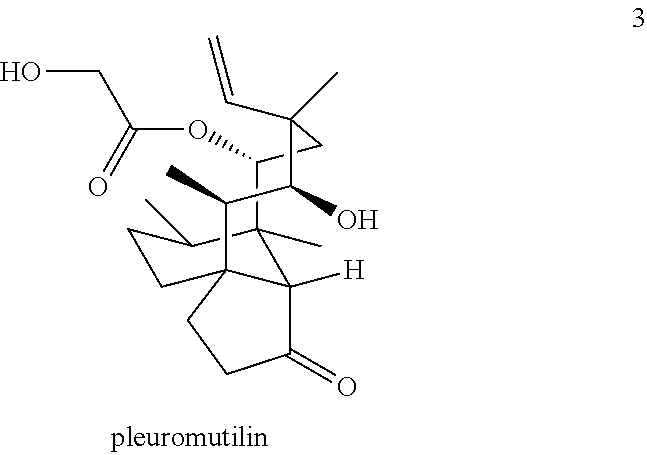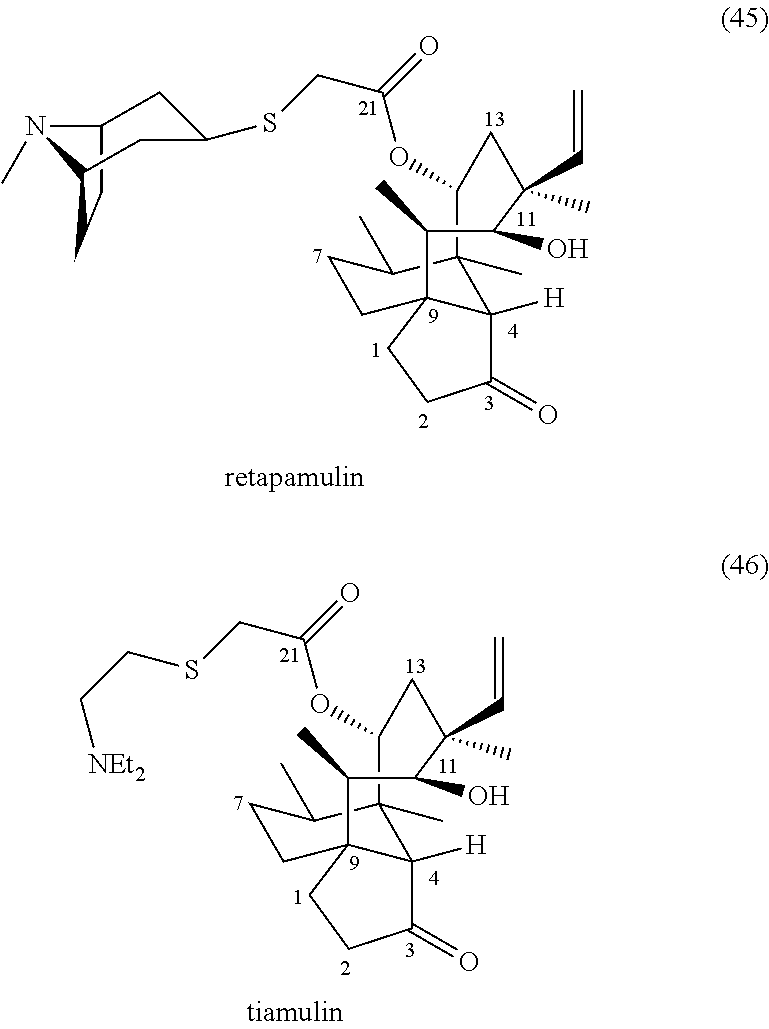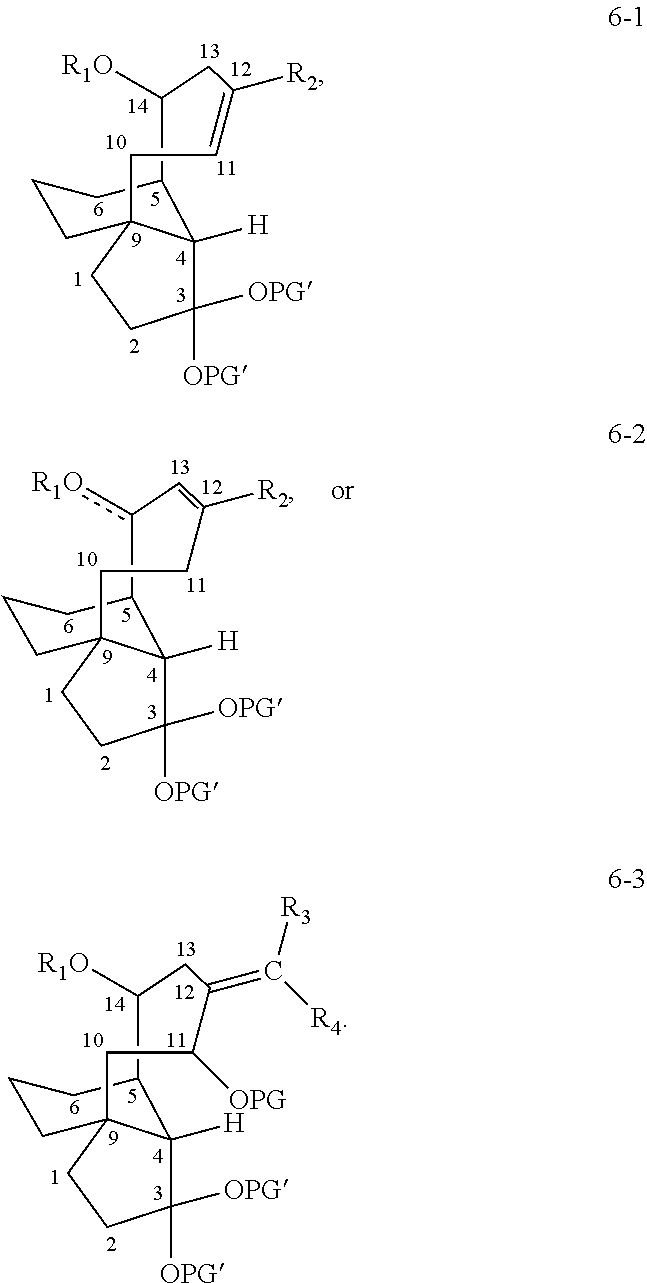Antimicrobial and antitubercular compounds
a technology of antitubercular compounds and antibacterial agents, which is applied in the direction of antibacterial agents, drug compositions, biocides, etc., can solve the problems of limiting the development of new antibiotics based on its structure, and the inability of intriguing compounds to achieve in vivo potency
- Summary
- Abstract
- Description
- Claims
- Application Information
AI Technical Summary
Problems solved by technology
Method used
Image
Examples
example 1
The first route utilizes an intramolecular ring-closing metathesis (RCM) reaction to establish the 8-membered ring:
RCM has emerged as a powerful tool for constructing medium and large rings; and the olefin that is left in its wake can be used for subsequent derivatization to make a pleuromutilin analog. For a review on the RCM reaction see: Furstner, A. “Olefin Metathesis and Beyond” Angew. Chem. Int. Ed. 2000, 39, 3012-3043, which is incorporated herein by reference as if fully set forth. Starting from enones 4 and 5, metathesis precursors 6 and 7 were obtained via short sequences. RCM provides the desired 8-6-5 tricycles 8 and 9 in 10 and 7 steps respectively. Subsequent modification of the resultant core may involve oxidation state and stereochemical manipulation due to geometrical constraints of RCM. Nevertheless, this strategy provides access to a variety of novel structures with features of pleuromutilin.
Compounds 6 and 7 were considered potential substrates for ring closure b...
example 2
The second route involves a sequential utilization of the Nozaki-Hiyama-Kishi (NHK) reaction to fashion the 8-membered ring of a more advanced pleuromutilin scaffold. A first phase included intermolecular NHK coupling; for example:
And the second phase included intramolecular NHK cyclization. An example of intramolecular NHK cyclization from the product directly above includes forming the following product:
The first phase and second phase examples directly above are not limiting.
Like RCM, the NHK process is also capable of forming medium-sized rings in an efficient manner.
Generally, a compound for entering NHK can be used in an intermolecular NHK reaction that affords a 1:1 epimeric mixture of products after a nitrile reduction and bromide formation. The resultant aldehyde can then participate in an intramolecular, diastereoselective NHK reaction. Attachment of a glycolic acid side-chain provides a 8-6-5 pleuromutilin scaffold. The NHK linchpin strategy was used to install a three ca...
example 3
Synthesis of Pleuromutilin and Pleuromutilin Analogs May Begin with an Asymmetric Construction of Dibromide 63
Standard Red-Al® reduction of 2-butyn-1-ol and iodine quench affords the known (Z)-vinyl iodide 60. Metal-halogen exchange with EtZnCl from 60 to 61 could be followed by a catalytic, asymmetric Negishi coupling with a-bromo amide 61 under Fu's conditions to provide allylic alcohol 62. Subsequent amide reduction and a two-fold bromination could furnish dibromide 63.
A sequential union of dibromide 63, isopropenyl cuprate 65, and cyclopentenone 64 may provide an advanced enol triflate 66:
Selective displacement of the allylic bromide in 63 would afford an intermediate (not shown) that could be converted to an organocuprate reagent. 1,4-Addition of this pre-formed species to cyclopentenone 64 followed by trapping with N-phenyltriflimide is may furnish enol triflate 66.
Palladium mediated borylation could then be followed by a copper (II) promoted alkoxylation with homoallylic alco...
PUM
| Property | Measurement | Unit |
|---|---|---|
| temperature | aaaaa | aaaaa |
| structure | aaaaa | aaaaa |
| pharmaceutical composition | aaaaa | aaaaa |
Abstract
Description
Claims
Application Information
 Login to View More
Login to View More - R&D
- Intellectual Property
- Life Sciences
- Materials
- Tech Scout
- Unparalleled Data Quality
- Higher Quality Content
- 60% Fewer Hallucinations
Browse by: Latest US Patents, China's latest patents, Technical Efficacy Thesaurus, Application Domain, Technology Topic, Popular Technical Reports.
© 2025 PatSnap. All rights reserved.Legal|Privacy policy|Modern Slavery Act Transparency Statement|Sitemap|About US| Contact US: help@patsnap.com



